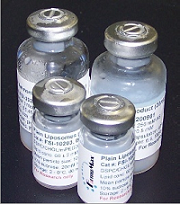PEGylated Liposomes for Loading Hydrophobic Drugs
본문
|
PEGylated Liposomes for Loading Hydrophobic Drugs
This pre-formed liposome product is created for post loading of hydrophobic small molecule compounds into liposomes. The process of drug incorporation is very straight-forward. Then simply add an aliquot of drug solution (prepared in a water-miscible solvent such as ethanol, DMSO and etc.) into the liposome suspemsion. The drug molecules can be incorporated into the lipid bilayers by the nature of hydrophobic interactions. The drug solubility therefore could be significantly enhanced. Liposomal drug concentration of 1-2 mg/mL could be achieved for most lipophilic drugs. PEGylation of the liposomes provides not only better formulation stability but also the potential of achieving prolonged in vivo blood circulation. The finished drug loaded formulations are suitable for either in vitro testing or in vivo studies.
Specifications • Lipids: Phosphatidylcholine and mPEG2000-DSPE (95:5 mol%) • Total lipid content.: 220 mgs in 5 mL • Lipid concentration: 50mM • Mean particle size: 100 nm (90-120 nm) • Buffer solution: PBS pH 7.0 – 7.4 (phosphate buffered saline) • Shelf-life: 6 months stored at 2-8 °C (guaranteed for non-drug loaded, replacement only)
Method of Drug Loading 1. Prepare a concentrated drug solution (20-50x of the final targeted drug concentration) in a water-miscible solvent, such as ethanol, DMSO and etc. 2. Aliquot out appropriate amount of the above reconstituted liposomes into a container such as a 15 mL centrifuge tube 3. Pre-warm the liposomes to 45-50°C in a water bath 4. To the liposome solution, slowly add appropriate amount of the above drug solution (preferably using a positive displacement pipette for good accuracy) to the liposome solution while vortexing at medium speed 5. Incubate drug/liposome mixture in the water bath with frequent mixing for 60 min 6. The drug loading is completed.
Additional Information 1. Keep the final solvent content below 5%, since too much solvent may affect the integrity of the liposomes 2. The solvent in the final formulation could be removed by dialysis or gel filtration column if necessary 3. The final formulation could be sterile filtered for long term storage 4. Some drugs post loading may gradually crystalize out over time, so it is advised to monitor the stability of the drug-loaded formulations 5. The drug crystals can be monitored under optical microscope, though a more reliable analytical assay, i.e. HPLC, is desired 6. The turbidity may increase slightly due to the incorporation of the drug. But if it becomes significantly cloudy, it may indicate the drug is over loaded. Reduce the drug/lipid ratio if this happens.
Drug Loading Optimization 1. The capacity of the liposomes for the hydrophobic drug loading really depends on the nature of the drug, so optimization is necessary to determine the maximum drug loading capacity. 2. Conduct drug loading in small volumes at a series of increasing drug/lipid ratios 3. The pH may also affect the drug loading, use a pH at where the drug is the most lipophilic, but keep in the range of 4-8 4. Observe the presence of drug crystals under microscopy and/or by centrifugation to pellet down the drug crystals 5. Identify the maximum drug/lipid ratio at which no or minimal drug crystals seen 6. It is recommended to monitor the stability for a period of time, because drug may crystalize out over time 7. Conduct the final drug loading at or below the maximum drug/lipid ratio determined.
|
Ordering information
|
Catalog No. |
Product Name |
Size |
|
F10209D |
PEGylated Liposomes for Loading Hydrophobic Drugs |
5.0 ml |
▣ 관련 페이지 ; FormuMax Scientific
- 이전글Alenphosome™- Alendronate Liposomes (Neutral) 18.04.24
- 다음글Lyophilized Clophosome Clodronate Liposomes 17.07.24
댓글목록
등록된 댓글이 없습니다.
